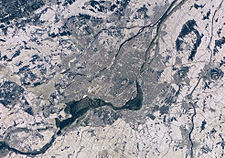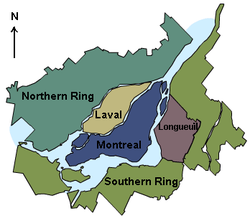- Greater Montreal
-
Greater Montreal
Grand Montréal— Metropolitan area — Montreal Metropolitan Community Motto: L'espace pour se réaliser
Room to make it realCountry Canada Province  Quebec
QuebecArea – Total 4,258.97 km2 (1,644.40 sq mi) Population (2010) – Total 3,859,318 – Density 906.2/km2 (2,347.1/sq mi) Time zone EST (UTC-5) – Summer (DST) EDT (UTC-4) Postal code prefixes H, J Area code(s) 438, 450, 514, 579 Greater Montreal is one of the two metropolitan communities of Quebec.
Greater Montreal is the most populous metropolitan area in Québec. As of 2009, Statistics Canada identifies Montréal's Census Metropolitan Area (CMA) (land area 4,259 square kilometres (1,644 sq mi)) as Canada's second most populous with a population of 3,859,318.[1] A smaller area of 3,838 square kilometres (1,482 sq mi) is governed by the Montreal Metropolitan Community (MMC) (French: Communauté métropolitaine de Montréal, CMM). This level of government is headed by a president (currently Montréal mayor Gérald Tremblay).
The inner ring is composed of densely populated municipalities located in close proximity to Downtown Montreal. It includes the entire Island of Montreal, Laval, and the Urban Agglomeration of Longueuil.
The outer ring is composed of low-density municipalities located on the fringe of Metropolitan Montreal. Most of these cities and towns are semi-rural. Specifically, the term off-island suburbs refers to those suburbs that are located on the North Shore of the Mille-Îles River, those on the South Shore that were never included in the megacity of Longueuil, and those on the Vaudreuil-Soulanges Peninsula. Communities in that area are also informally referred to as the 450, after the telephone area code that has served the region since 1998.
Due to their proximity to Montreal's downtown core, some suburbs on the South Shore (Longueuil, Brossard, Saint-Lambert, and Boucherville) are usually not included in the off-island suburbs even though they are on the mainland.
Contents
Largest cities
Rank City Region Population (2006) Land Area Population Density km2 mi2 /km2 /mi2 1 Montréal Montreal 1,620,693 365.13 140.98 4,438.7 11,496 2 Laval Laval 368,709 247.09 95.40 1,492.2 3,865 3 Longueuil South Shore 229,330 115.59 44.63 1,984.0 5,139 4 Terrebonne North Shore 94,703 154.60 59.69 612.6 1,587 5 Repentigny North Shore 76,237 61.76 23.85 1,234.5 3,197 6 Brossard South Shore 71,154 45.20 17.45 1,574.3 4,077 7 Dollard-des-Ormeaux West Island 48,930 15.10 5.83 3,240.0 8,392 8 Blainville North Shore 46,493 55.10 21.27 843.8 2,185 9 Châteauguay South Shore 42,786 35.89 13.86 1,192.1 3,088 10 Saint-Eustache North Shore 42,062 69.42 26.80 605.9 1,569 Cities and towns

 A panorama of Downtown Montreal and part of its metropolitan area taken from the Chalet du Mont Royal at the top of Mount Royal
A panorama of Downtown Montreal and part of its metropolitan area taken from the Chalet du Mont Royal at the top of Mount RoyalIsland of Montreal
- Montreal West
- Mount Royal
- Pointe-Claire
- Sainte-Anne-de-Bellevue
- Senneville
- Westmount
Laval
Montérégie
- Kahnawake (native reserve)
Beauharnois-Salaberry
- Beauharnois
- Salaberry-de-Valleyfield
Lajammerais
- Calixa-Lavallée
- Contrecœur
- Saint-Amable
- Sainte-Julie
- Varennes
- Verchères
La Vallée-du-Richelieu
- Belœil
- Carignan
- Chambly
- McMasterville
- Mont-Saint-Hilaire
- Otterburn Park
- Saint-Basile-le-Grand
- Saint-Jean-Baptiste
- Saint-Mathieu-de-Beloeil
Roussillon
- Candiac
- Châteauguay
- Delson
- La Prairie
- Léry
- Mercier
- Sainte-Catherine
- Saint-Constant
- Saint-Isidore
- Saint-Mathieu
- Saint-Philippe
Rouville
- Richelieu
- Saint-Mathias-sur-Richelieu
Urban Agglomeration of Longueuil
- Boucherville
- Brossard
- Longueuil
- Saint-Lambert
- Saint-Bruno-de-Montarville
Vaudreuil-Soulanges
- Coteau-du-lac
- Hudson
- Les Cèdres
- Les Coteaux
- L'Île-Cadieux
- L'Île-Perrot
- Notre-Dame-de-l'Île-Perrot
- Pincourt
- Pointe-des-Cascades
- Rigaud
- Rivière-Beaudette
- Saint-Zotique
- Saint-Lazare
- Terrasse-Vaudreuil
- Vaudreuil-Dorion
- Vaudreuil-sur-le-Lac
Laurentians
- Blainville
- Bois-des-Filion
- Boisbriand
- Deux-Montagnes
- Lorraine
- Mirabel
- Oka
- Pointe-Calumet
- Rosemère
- Sainte-Anne-des-Plaines
- Saint-Eustache
- Saint-Jérôme
- Saint-Joseph-du-Lac
- Sainte-Marthe-sur-le-Lac
- Sainte-Thérèse
Lanaudière
- Charlemagne
- L'Assomption
- Mascouche
- Repentigny
- Saint-Sulpice
- Terrebonne
Demographics
Main article: Demographics of MontrealMother tongue languages (2006)[2] Language Greater Montreal Quebec Canada French 66.5% 80.1% 22.3% English 13.2% 8.6% 58.4% Italian 3.5% 1.8% 1.5% Arabic 3.1% 1.6% 0.9% Spanish 2.6% 1.5% 1.2% Creole 1.4% 0.7% 0.2% Chinese 1.2% 0.6% 1.5% Greek 1.2% 0.6% 0.4% Portuguese 0.9% 0.5% 0.7% Romanian 0.7% 0.4% 0.3% Berber 0.7% 0.4% 0.3% Vietnamese 0.7% 0.4% 0.5% Russian 0.5% 0.3% 0.4% Armenian 0.4% 0.2% 0.1% Polish 0.4% 0.2% 0.7% Transportation
Main article: Agence métropolitaine de transportThe Agence métropolitaine de transport (AMT) (English: Metropolitan Transportation Agency) plans, integrates, and coordinates public transport across Greater Montreal, including the Island of Montreal, Laval (Île Jésus), and communities along both the north shore of the Rivière des Mille-Îles and the south shore of the Saint Lawrence River. Established in 1996, the AMT's commuter rail system has five lines linking the downtown core with communities as far west as Rigaud, as far east as Mont-Saint-Hilaire, and as far north as Saint-Jérôme. AMT's mandate also includes the management of reserved High-occupancy vehicle lanes, metropolitan bus terminuses, park-and-ride lots, and a budget of $163 million, which is shared amongst the transit corporations and inter-municipal public transit organizations. The AMT's territory spans 63 municipalities and one native reserve, 13 regional county municipalities, and 21 transit authorities. It serves a population of approximately 3.7 million people who make more than 750,000 trips daily.[citation needed]
The major transit commissions under the Metropolitan Transit Agency are:
- Société de transport de Montréal (English: Montreal Transit Corporation), serving the Island of Montreal
- Société de transport de Laval (English: Laval Transit Corporation), serving the city of Laval
- Réseau de transport de Longueuil (English: Longueuil Transit Network), serving the Urban agglomeration of Longueuil
Additionally, there are numerous smaller transit agencies known as Conseil Intermunicipal de Transport (CIT) (English: Intermunicipal Transit Councils).
Education
Greater Montreal is home to a number of higher education institutions, including:
Universities
- Concordia University (Montreal)
- McGill University (Montreal)
- Université de Montréal (Montreal)
- Université du Québec à Montréal (Montreal)
- Université de Sherbrooke (Longueuil)
CEGEPs and community colleges
- Cégep André-Laurendeau (Montreal)
- Cégep Marie-Victorin (Montreal)
- Cégep de Saint-Laurent (Montreal)
- Cégep du Vieux-Montréal (Montreal)
- Champlain College Saint-Lambert (Saint-Lambert)
- Collège Ahuntsic (Montreal)
- Collège de Bois-de-Boulogne (Montreal)
- Collège Édouard-Montpetit (Longueuil)
- Collège Gérald-Godin (Sainte-Geneviève)
- Collège Jean-de-Brébeuf (Montreal)
- Collège Lionel-Groulx (Sainte-Thérèse)
- Collège de Maisonneuve (Montreal)
- College Montmorency (Laval)
- Collège de Rosemont (Montreal)
- Dawson College (Westmount)
- Herzing College (Montreal)
- John Abbott College (Sainte-Anne-de-Bellevue)
- LaSalle College (Montreal)
- Marianopolis College (Westmount)
- Vanier College (Montreal)
- Collège de Valleyfield (Salaberry-de-Valleyfield)
Other schools
- Lambda School of Music and Fine Arts (Montreal)
- National Theatre School of Canada (Montreal)
- Rabbinical College of Canada (Montreal)
See also
References
- ^ "Annual Demographic Estimates: Subprovincial Areas: Table 1.3-1 — Annual population estimates and demographic factors of growth by census metropolitan area, Canada, from July to June — Population estimates and factors of growth". Statcan.gc.ca. 2011-02-03. http://www.statcan.gc.ca/pub/91-214-x/2009000/t021-eng.htm. Retrieved 2011-08-29.
- ^ "Montreal (CMA) - Detailed Mother Tongue". Canada 2006 Census. Statistics Canada. April 1, 2008. http://www12.statcan.ca/english/census06/data/topics/RetrieveProductTable.cfm?ALEVEL=3&APATH=3&CATNO=97-555-XCB2006007&DETAIL=0&DIM=&DS=99&FL=0&FREE=0&GAL=0&GC=99&GK=NA&GRP=1&IPS=97-555-XCB2006007&METH=0&ORDER=1&PID=89186&PTYPE=88971&RL=0&S=1&ShowAll=No&StartRow=1&SUB=701&Temporal=2006&Theme=70&VID=0&VNAMEE=&VNAMEF=&GID=837977. Retrieved 2008-05-18.
External links
- Metropolitan Community of Montreal website
- Greater Montreal Area Restaurants
- (French) Greater Montreal Area map in .pdf
Urban agglomeration of Montreal Greater MontrealMunicipalities 
West Island municipalities Baie-d'Urfé · Beaconsfield · Dollard-des-Ormeaux · Dorval · Kirkland · L'Île-Dorval · Pointe-Claire · Sainte-Anne-de-Bellevue · SennevilleBoroughs of Montreal Ahuntsic-Cartierville · Anjou · Côte-des-Neiges–Notre-Dame-de-Grâce · L'Île-Bizard–Sainte-Geneviève · Lachine · LaSalle · Mercier–Hochelaga-Maisonneuve · Montréal-Nord · Outremont · Pierrefonds-Roxboro · Le Plateau-Mont-Royal · Rivière-des-Prairies–Pointe-aux-Trembles · Rosemont–La Petite-Patrie · Le Sud-Ouest · Saint-Laurent · Saint-Léonard · Verdun · Ville-Marie · Villeray–Saint-Michel–Parc-ExtensionNeighbourhoods of Montreal Ahuntsic · Bois-Franc · Bordeaux-Cartierville · Centre-Sud · Chinatown · Cité du Havre · Cité Multimédia · Côte-des-Neiges · Côte-Saint-Paul · Downtown · Garment District · Gay Village · Glenmount · Golden Square Mile · Goose Village · Greektown · Griffintown · Historic Jewish Quarter · Hochelaga-Maisonneuve · La Petite-Patrie · L'Île-Bizard · Little Burgundy · Little Italy · Little Maghreb · Little Portugal · McGill Ghetto · Mercier-Est (Tétreaultville) · Mercier-Ouest (Longue-Pointe) · Mile End · Monkland Village · Notre-Dame-de-Grâce · Nouveau Bordeaux · Nuns' Island · Old Montreal · Overdale · Park Extension · Pierrefonds · Pointe-Saint-Charles · Pointe-aux-Trembles · Quartier Bonaventure · Quartier Concordia · Quartier International · Quartier Latin · Quartier du Musée · Quartier des Spectacles · Red Light District · Rivière-des-Prairies · Rosemont · Roxboro · Technoparc · Saint-Henri · Sainte-Marie · Saint-Michel · Sainte-Geneviève · Saraguay · Sault-au-Récollet · Shaughnessy Village · Snowdon · Viauville · Ville-Émard · Ville Saint-Pierre · VillerayFormer municipalities of Montreal Island Cartierville · Longue-Pointe · Mercier · New Bordeaux · Pierrefonds · Roxboro · Ville Saint-Laurent · TétreaultvilleUrban agglomeration of Longueuil Cities Boroughs of Longueuil Pre-2002 towns and cities (now merged) Jacques-Cartier · Mackayville-Laflèche · LeMoyne · Montreal South (Montréal-Sud) · Notre-Dame-du-Sacré-Cœur · PrévillePolitics Transportation Réseau de transport de Longueuil (RTL) · Longueuil–Université-de-Sherbrooke (Montreal Metro) · Montréal/Saint-Hubert Airport · Jacques-Cartier Bridge · Champlain Bridge · Victoria Bridge · Louis-Hippolyte Lafontaine Bridge-Tunnel · Taschereau Boulevard · Victoria AvenueHealth and Safety Hôpital Charles LeMoyne · Hôpital Pierre-Boucher · Service de police de Longueuil (SPL) · Service de Sécurité incendie de Longueuil (SSIL)Education Media CHAA-FM · Le Courrier du SudOther  City of Laval
City of LavalNeighbourhoods Administration Public services Other List of people from Laval, QuebecGreater Montreal Area • Administrative subdivisions of Quebec • Regions of Quebec • Municipal reorganization in Quebec Administrative divisions of Quebec
Administrative divisions of QuebecSubdivisions Administrative regions · Regional county municipalities · Montreal Metropolitan Community (Communauté métropolitaine de Montréal) · Communauté métropolitaine de Québec · Kativik Regional Government
Communities Major cities Montreal · Quebec · Laval · Gatineau · Longueuil · Sherbrooke · Saguenay · Lévis · Trois-Rivières
Other cities Alma · Amos · Baie-Comeau · Belœil · Châteauguay · Cowansville · Dolbeau-Mistassini · Drummondville · Granby · Joliette · La Tuque · Lachute · Matane · Mont-Laurier · Rimouski · Rivière-du-Loup · Rivière-Rouge · Rouyn-Noranda · Saint-Georges · Saint-Hyacinthe · Saint-Jean-sur-Richelieu · Saint-Jérôme · Salaberry-de-Valleyfield · Sept-Îles · Shawinigan · Sorel-Tracy · Thetford Mines · Val-d'Or · Varennes · Victoriaville
Census metropolitan areas (CMAs) in Canada by size Toronto, ON · Montreal, QC · Vancouver, BC · Ottawa, ON · Calgary, AB · Edmonton, AB · Quebec City, QC · Winnipeg, MB · Hamilton, ON · London, ON · Cambridge-Kitchener-Waterloo, ON · St. Catharines-Niagara, ON · Halifax, NS · Oshawa, ON · Victoria, BC · Windsor, ON · Saskatoon, SK · Regina, SK · Sherbrooke, QC · St. John's, NL · Barrie, ON · Kelowna, BC · Abbotsford, BC · Greater Sudbury, ON · Kingston, ON · Saguenay, QC · Trois-Rivières, QC · Guelph, ON · Moncton, NB · Brantford, ON · Thunder Bay, ON · Saint John, NB · Peterborough, ON
Categories:- Municipal government of Montreal
- Metropolitan areas of Canada
- Greater Montreal
Wikimedia Foundation. 2010.



